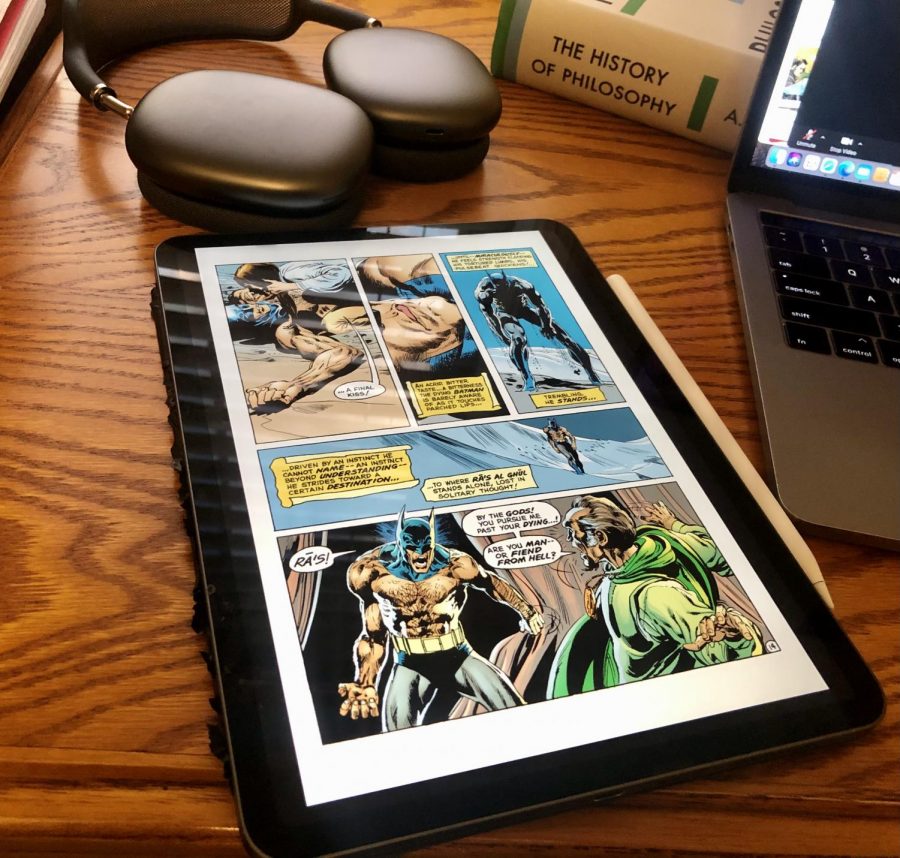There’s never been a better time to get into comic books
Read classics like “Batman 244” by Denny O’Neil and Neal Adams right on your smart devices with services like DC Universe Infinite and Marvel Unlimited.
April 9, 2021
I’ve been a comic book fan for as long as I can remember. I have a faint memory of being given a copy of “Batman: The Long Halloween” in a comic book shop when I was six, and the rest was history. Comic books, and sequential art in general, are one of the only completely American artforms out there, having evolved and influenced the works of the 20th century. While comic books might not have the same popularity they once had with the American populace, the superheroes born of this medium continue to dominate almost every other piece of media out there.
Characters like Superman, Batman, Spider-Man and Captain America have taken hold in the public consciousness with movie after movie pumped out featuring their likeness. For good reason, as well––superheroes are pretty rad. Their unique versatility means that they can be placed in almost any situation or genre and still be able to save the day. A character like Batman can be in a campy ‘60s TV show with punches followed by “wham” and “pow” screen effects and can also be in a gritty psychological crime thriller.
However, consumers who just watch the shows and the movies are missing out on the vast majority of amazing and varied superhero stories out there, because comic books are still here, and they are better and more accessible than ever.
Part of the appeal of the Marvel Cinematic Universe has been the serialized nature of the films. Viewers are able to follow characters for years on end until their storylines all culminate in a massive crossover event a la “Avengers: Infinity War” or “Avengers: Endgame.” Now, imagine a storytelling style where narratives can be built across decades, with new installments coming out on a monthly basis. Also, because of the nature of sequential art, you don’t need to worry about overdone action or the authenticity of the characters, because everything is drawn. The beautiful art can take any shape in a way that films that rely on CGI just can’t without having budgets in the millions of dollars. Due to this, comic books have infinite storytelling and visual possibilities, more so than any other narrative medium out there. That’s pretty cool.
Okay, now say that you’re convinced and you want to give comics a try. Well, it’s rather expensive isn’t it? New installments in the stories of your favorite characters may come out every month, or sometimes twice a month, but each issue costs an average of $5 which adds up quickly if you want to follow multiple character and team books each week. Some of this can be avoided if you are willing to wait a bit for trade collections to come out, meaning that you can get six or so issues at a time for $20 a pop, but it’s still quite an expensive hobby.
Besides that, even if you were to invest in a comic book collection, where are you going to keep it? As college students, we don’t exactly have a whole bunch of space for long boxes filled with issues and trade collections that take up entire shelves at times.
Well fortunately for us, we live in the digital age, and while the comic book industry has been slow on the uptake, accessible digital comics are finally a reality. Readable on phones, tablets and computers––your digital comic collection is with you wherever you are. This new platform takes up much less space while still delivering all the superhero fun one could desire. You can buy digital comics, but that can be just as expensive as physical ones. Fortunately in recent days companies like Marvel and DC have made their own comic subscription services, Marvel Unlimited and DC Universe Infinite, respectively.
Containing access to each companies’ entire back catalogue, the services are of tremendous value, with Marvel’s option costing either $10 a month or $70 a year, and DC’s option costing $8 a month or $75 a year. For that money, you get access to over 28,000 comics with Marvel Unlimited and over 24,000 comics with DC Universe Infinite. Along with all of these old comics, both services are updated regularly with new issues a few months after their initial physical release. So, theoretically, if you wanted to read every single issue of “The Amazing Spider-Man” from 1963 on or almost every issue of “Batman” from the 1940s to today, it’s all accessible.
But of course, that is an overwhelming amount of content there. The complaint I’ve heard the most about getting into comics is just the sheer amount of content out there and uncertainty about good jumping on points. Let me make this clear: you do not need to read every single issue of “Superman,” or any other comic, to know what’s going on in the current comics. When new writers jump onto a title, they often start with a blank slate creatively, with all the toys back in the box so to speak, before unraveling their own narrative and taking everything out of the box. So really, it’s just important to keep an eye out for when a new creative team is involved, because they will probably want to tell their own story. While part of the appeal of comic books is their multi-decade world building, most change is pretty gradual and the beginnings of creator runs don’t require too much prior knowledge to just jump into.
That being said, part of the appeal of the streaming services is their immense curation, with reading lists that give you the highlights of the large collection while focusing on the greatest hits of a certain character or certain creator. This also helps to cut down on confusion when different series cross over together for an event storyline, as readers can now follow the lists directly to see how the event unravels across lines without fear of missing anything. I slightly prefer DC’s curation here––it highlights certain ages of comic book history more so than Marvel––but both options are extensive.
So, subscribe to whichever service you are interested in, choose a character or creator you are interested in, and just dive in. It’s never been easier. We are living in a golden age of comic book accessibility and diversity, with titles coming out today that are pushing the medium to its farthest creative boundaries. And if new comics aren’t quite your thing, there are tens of thousands of older ones just waiting to be discovered. I’m personally a fan of 1970s Batman comics. I’m sure you’ll find your niche as well.
So many when you are turning on your TV to watch the latest episode of “The Falcon and the Winter Soldier,” or the fourth hour of “Zack Snyder’s Justice League,” grab your device and see where the ideas came from, and where the stories are going next.



